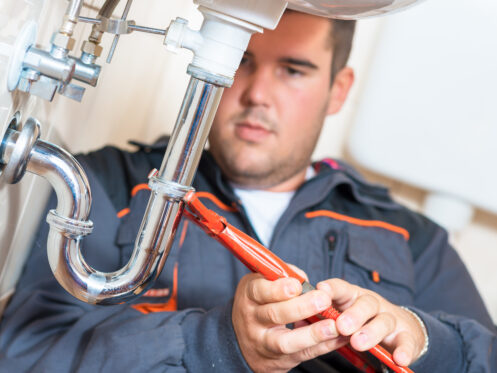Water conservation is a critical issue for Colorado homeowners due to prolonged droughts and growing demand for water resources. By adopting water-saving practices, homeowners can do their part to save water and keep their utility bills as low as possible.
There are several ways that a homeowner can conserve water in their home. Our team at Jim Needham Heating Cooling Plumbing and Drain can come to your home, evaluate the water usage and waste, and offer a plan to address the need to save water.
Install Water-Efficient Fixtures
Water-efficient fixtures can considerably reduce water usage in your home. Some of the more common types include:
- Low-flow showerheads and faucets
- Dual-flush toilets
- High-efficiency appliances
Low-flow showerheads and faucets reduce the amount of water they put out while also maintaining water pressure. Understandably, some homeowners are hesitant to adopt low-flow fixtures due to the worries of water pressure. However, with improvements in plumbing technology over the years, low-flow fixtures generally maintain pressure while still reducing the amount of water you use.
Similarly, high-efficiency appliances are able to use less water than their traditional counterparts to get the same results. They’re often also more energy-efficient, saving you money on your utility bills as well. This is especially important with appliances like dishwashers. Many people think of them as water-wasters, which may have been more accurate previously. More modern dishwashers, though, use less water than an average human does when washing dishes.
Dual-flush toilets have a function for liquid waste and a separate one for solid waste. The liquid flush uses less water, meaning you can modulate your usage for whatever situation is appropriate.
Fix Leaks Promptly
Even the smallest drip from a leaky faucet in Thornton can waste a lot of water and increase your water bill. Fixing leaks can save countless gallons of water that could have been used for something else. Regularly checking all plumbing for the house to ensure it’s leak-free is critical. Don’t forget about the outside faucets, which can sometimes fail faster than interior faucets because of the freeze-thaw cycle that’s present in Colorado.
It’s possible that there are leaks that aren’t readily visible with a surface-level inspection of the plumbing, so you have to look beyond what you can see in the home. If you notice a sudden increase in your water bill that’s not attributable to any known reason, you may have a leak somewhere in your home.
Optimize Your Irrigation System
Many homeowners have irrigation systems so they can keep their landscaping as pristine as possible, maintaining the curb appeal of their homes. This can be a significant source of water usage for any homeowner. Irrigation can be convenient, but if used incorrectly, it can waste water. However, there are multiple steps you can take to reduce the water your irrigation system uses.
One option is for us to install a smart irrigation system controller. This will automatically adjust the watering schedule based on the soil moisture levels and current weather conditions. Some of these systems can be set so the irrigation system will only turn on when certain parameters are met.
Another option is a drip irrigation system. This delivers water directly to the plant roots to minimize any runoff or evaporation of water. These also enable you to pick and choose what areas of the lawn need to be watered at any given time.
Regardless of what type of irrigation or watering system is being used, it’s best to water the lawn early in the morning. Avoiding watering during the day prevents the evaporation that occurs in the heat of the day.
Choose Native and Drought-Resistant Plants
The possibilities are endless when it comes to landscaping your home. Instead of choosing flowers, shrubs, and plants that need considerable watering, you can choose to use drought-resistant options. These can dramatically reduce the amount of water that’s needed to keep your yard looking nice.
Another option is xeriscaping, which is a landscaping method that uses minimal water. It combines drought-tolerant plants and efficient design to reduce the amount of water that’s necessary to keep the landscaping beautiful.
If you don’t use only drought-resistant and native options, the focus should be on reducing how often everything needs to be watered. This may be possible if you use mulch to help retain soil moisture around those plants and flowers.
Collect Rainwater
Rainwater harvesting involves capturing, storing, and directing rainwater runoff so you can use it. There are several ways to do this.
One option is to have the gutters direct water to the landscaped areas. This is a convenient option for many homeowners.
You can also harvest rainwater using barrels. It’s important to note that Colorado has specific laws covering rainwater harvesting that’s collected in rain barrels. Each home can have up to 110 gallons of storage with up to two barrels. This water is safe to use for outdoor living spaces, plants, or gardens. Because this rainwater is untreated, though, it’s not safe to drink.
Adopt Water-Saving Habits
Small changes to your daily habits can save a lot of water and produce significant savings, as well. For example, turning off the water while you’re brushing your teeth can save gallons of water each time you brush. Consider placing a small cup by the sink so you can put just enough water in it to swish around your mouth.
Shortening your shower time can also help. If you can keep it around the five-minute mark, that minimizes the amount of water wasted during the typical showering process. Also, while you lather up your hair and body, turn your showerhead off. (Alternately, take advantage of low-flow showerhead features; many of them let you moderate water usage mid-shower.) Either way, turn the water back on when it’s time to rinse. If you get cold without hot water, you can install heat-generating bulbs in your bathroom fixtures to help mitigate that.
You can also save money cleaning things other than yourself. Run dishwashers and washing machines only when they’re full so no water is wasted. (This can also help to minimize the wear and tear on your hot water heater, which can also help you save water.)
Consider a Tankless Hot Water Heater
Tankless hot water heaters can conserve water and electricity because they only heat up the water you actually want to use. If there’s an issue with the tankless hot water heater, you won’t have to drain gallons upon gallons of water so the problem can be fixed. With a traditional water heater, draining all that water is a serious waste when something goes wrong.
Contact Jim Needham Heating Cooling Plumbing and Drain Today
Homeowners in Colorado know that water is a precious resource that must be protected. Conserving it isn’t just good for the environment; it can also help you save on your utility bills.
Jim Needham Heating Cooling Plumbing and Drain plumbers are ready to work with you to meet your water conservation goals. From checking for leaks to installing kitchen and bathroom fixtures that will help to save water, our professionals are ready to get started. Give us a call today to get your appointment set for our plumbing repair and maintenance services.

